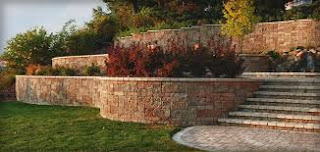A project installed by DLG is always one of quality, creativity and lasting beauty that adds to your enjoyment of life as well as to the value and functionality of your property. Our landscapes are naturally unique, with personalities that befriend their surroundings and compliment local topography. Our knowledge and experience, coupled with that of industry affiliates when needed, gives us a range of skills and services that can see any size project to a timely and satisfactory completion.
We offer free, on-site initial consultations. Call us Today to schedule yours. (612) 702-3569
Retaining Walls
 |
| This slope, steep as it is, will be retained with plantings |
 |
| A low wall for seperation |
If you're at the point where you have your heart set on adding a retaining wall but you are sure that you don't want it to overpower it's surroundings such as the one shown below, try terracing.
 |
| Too big-will fail |
To decrease the amount of retainment material that you'll use, you can also slope soils between walls.
Boulder Walls
 |
| Terraced walls are beautiful |
Boulder walls are the most common retaining wall installed today. Boulders are everywhere and easily attainable. The application of their use compliments our natural topography and balances well with most types of home construction. Boulder walls are stable when properly installed but can be subject to erosion by heavy rains.
Because boulders are all different in size and shape, boulder walls are built more as a puzzle than as a pattern. Although boulders within a wall are connected together in a limited way, they are not as durable in their construction as that of a modular block wall.
 Modular Block Walls
Modular Block WallsModular blocks are solid concrete blocks that interlock with one another through overlapping and alternating seams while using built-in mechanisms such as lips and protusions or external mechanisms such as pins and clips to lock them together and secure them in place. Modular blocks come in different heights, lengths and styles. The latest technology in modular block development has been in the use of colors, facia textures, patterns (such as ashlar) and freestanding wall blocks that have two or more outward facing sides. The height of the wall determines the size of the block needed.
Modular walls are very stable and durable when properly constructed. The recent introduction of resins and fibers to the concrete mixture has added to the longevity of modular blocks as compared with the introductory product models of the1980's.
Modular blocks are priced to be a mid range choice for retaining wall applications. Because of the advancements in modular block technology and its ever increasing popularity due to its resemblence to natural stone, modular block has found a permanent place within the landscape construction industry.
 |
| Ashlar Pattern |
Douglas Larson Gardens uses brands such as Belgard, Anchor, Interlock and Rockwood in it's applications. A well-constructed retaining wall should have a deep, well compacted base and good drainage.
With the advent of the multi-faced block has come the pillar block. Pillars are quite easy to assemble and can also be affixed with lighting or used as footings for posts in the construction of pergolas and arbors.
Natural Stone Walls
Natural stone walls differ from boulders in that they are sedimentary stones rather than glacial. These natural stones such as limestone, bluestone and sandstones are harvested out of quarries in Minnesota, Wisconsin and New York. Most natural stone types come in flagstone (thickness less than 3") which is used for patio's and other flooring applications and block stone, which is used for constructing walls, natural steps and masonry applications such as veneer.
 |
| Chilton Limestone (Full Color) |
Oftentimes sand or other more permenant materials such as mortar or concrete is used to bind the stones together. We find that using a sealer binding agent in the sand beneath and between the stones creates the nicest look and provides good annual protection.
Natural stone can be expensive in its applications. However, nothing proves its longevity like natural stone that has stood the test of time.
Natural stone wall construction is only limited by availability of product. Constructing stone walls requires an artist who has advanced training in constructing walls of this nature.
 |
| Bigger stone means faster installation |
Alternatives to Retaining Walls
Earlier in the article we mentioned the idea of planting a slope with erosion control type plants. Another method is to randomly place boulders known as "outcroppings" into a hillside and incorporate plantings in and among them. The photo (left) shows outcropping stone being effectively used as wall stone.
Outcropping applications are beautiful and very natural looking-costing just a fraction of what a retaining wall would cost.
Some of the greatest plants for erosion control are; Sumacs, Elderberry's, Gray Dogwood, Euonymus and native grasses. To see more plants for erosion control click here.
 |
| Basalt Outcropping |
For a free on site consultation and estimate
call Douglas Larson Gardens
(612) 702-3569




No comments:
Post a Comment